Wellness
oi-Amritha K
on June 20, 2021
The International Day of yoga has been celebrated annually on 21 June since 2015. The United Nations General Assembly established the day in 2014, first proposed by the current Prime Minister of India, Narendra Modi, during his speech at the United Nations General Assembly (UNGA), on 27 September 2014 [1]. The theme for International Day of Yoga 2021 is ‘Yoga for Wellbeing.’
In the event of International Day of Yoga 2021, let’s look at some yoga poses that are beneficial to children.
Yoga For Children: Is It Beneficial?
In today’s busy world, it is not just the adults but also the kids who need a stressbuster, a way out to cope with stress and have a balance in life and mental health. A dedicated and intentional yoga practice that includes breathing techniques, behavioural guidelines, and physical postures can be beneficial for the kids emotionally, socially and emotionally [2].
Yoga For Headache: 20 Yoga Asanas To Help You
When starting your kids with yoga, please start the process slowly. Then, once they seem comfortable and interested, introduce breathing and meditation exercises along the way.
Some of the health benefits of yoga for kids:
- Improves body balance, strength, and flexibility
- Helps reduce chronic pain such as muscle pain
- Enhances the quality of sleep
- Help reduce the release of stress hormones like cortisone, and, therefore, is effective in reducing stress, anxiety, and fatigue
- Helps improve resilience, mood, and self-regulation skills
Here are some easy yoga poses that are beneficial for children:
Note: These yoga poses should be done under adult/parental supervision.
7 Best Yoga Asanas For Normal Delivery
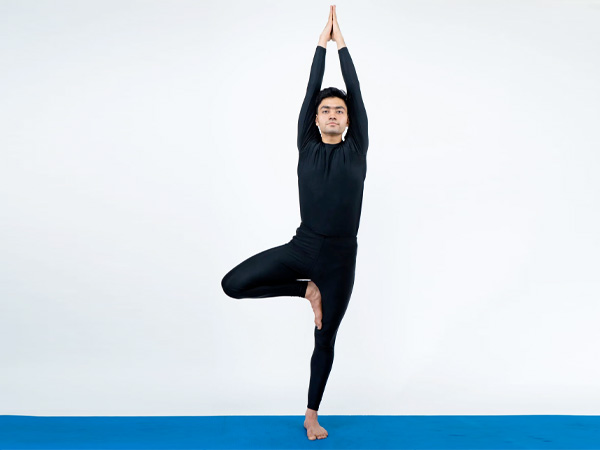
1. Tree Pose or Vrikshasana
Vriksha means tree in Sanskrit. The final posture of this asana resembles the shape of a tree, hence, the name. Practising the tree pose is shown to strengthen the legs, improve neuromuscular conditions, and balance and endurance [3].
How to do Vrikshasana
- Starting by standing straight with arms by the side of the body
- Lift the right foot with the knee out.
- Exhale, move the right leg up and place the foot on the inner side of the left thigh.
- Press the hands together above the head.
- Focus on a point in the front.
- Hold the position for 30 seconds to a minute.
- Return the hands to the chest and then lower the right leg.
- Repeat it on the left leg.
Note for parents: If the child finds it difficult to hold their posture, you may make them stand with their back against a wall to steady themselves.
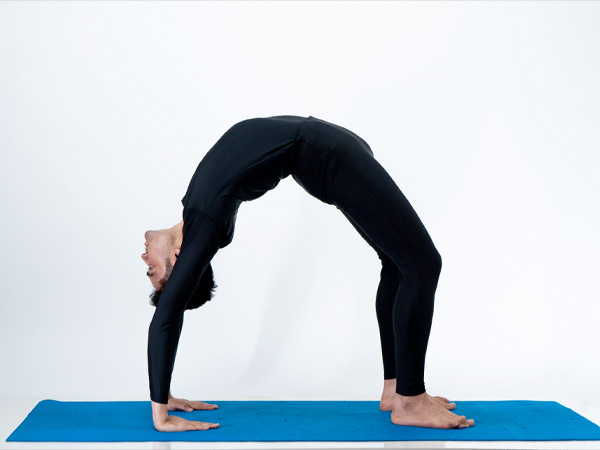
2. Bridge Pose (Setu Bandhasana)
The bridge pose help rejuvenate your body. Carrying out the pose will energise and relax your body simultaneously and give a good stretch to the spine and thighs [4].
How to do Setu Bandhasana
- Lie flat on the floor, and if necessary, place a thickly folded blanket under the shoulders to protect the neck.
- Bend knees and set feet on the floor, heels as close to the hip bones as possible.
- Breathing out, pressing your inner feet and arms actively into the floor, pushing your tailbone upward toward the pubic bone, firming up the buttocks, and lifting the buttocks off the floor. Keep your thighs and inner feet parallel.
- Clasp the hands below your pelvis and extend the arms to help you stay on the top of your shoulders.
- Lift your buttocks until the thighs are about parallel to the floor.
- Have the fingers interlaced and hands pushed to the ground to help lift the torso higher.
- Stay in the pose anywhere from 1-30 seconds.
- As you breathe out, release the pose, rolling the spine slowly down onto the floor.
Note for parents: In case of any neck or shoulder pain, take assistance from a professional.
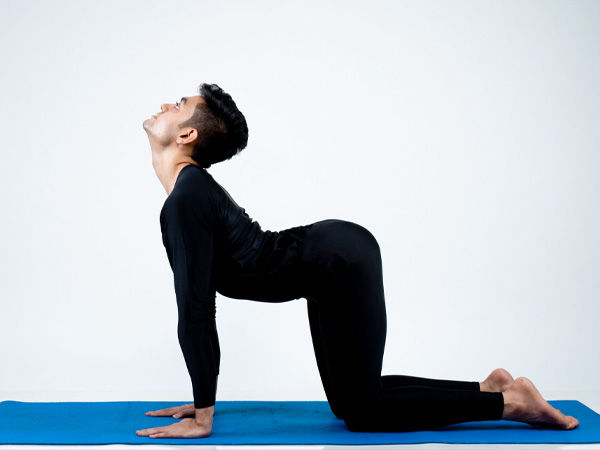
3. Cat Pose (Marjaryasana)
Also termed as the cat and cow pose, this is a combination of two asanas-the pose massages the stomach and intestines and the back and core.
How to do Marjaryasana:
- Get down onto your hands and knees and place each hand directly under the shoulder and each knee under the hip.
- Point your fingers up to the top of your mat.
- Looking downwards, relax your head and neck into a neutral position.
- Breathe in and relax your belly toward the floor.
- Lift your chin and chest, look up to the ceiling, hold the pose for 5-6 seconds.
- Now, exhale while pulling your belly in toward your spine.
- Round your back and allow your head and neck to relax back downward.
- Repeat this 2-4 times.
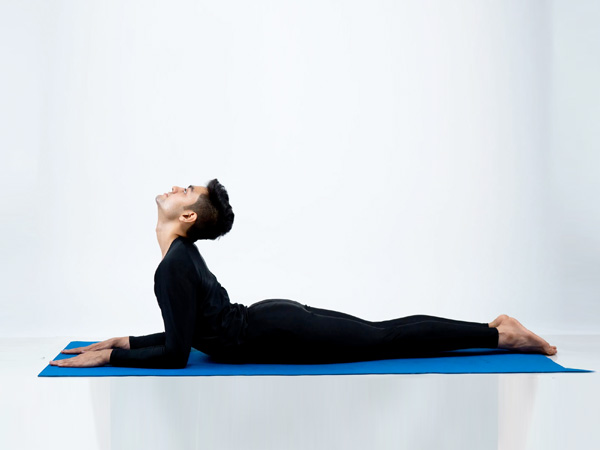
4. Cobra Pose (Bhujangasana)
This yoga pose is also a part of the traditional Surya Namaskar sequence and is easy to learn. In addition, the cobra pose is proven to be beneficial for relieving pain and uneasiness in the muscles of the back, neck and abdomen. Moreover, practising bhujangasana regularly will help in managing stress and anxiety [5][6].
How to do Bhujangasana:
- Lie on your stomach and keep your forehead on the floor, with your feet placed together.
- Press the floor using the top of your feet.
- Place your hands under the shoulders and keep your elbows close to your body.
- Maintain the position with your shoulder blades back and downward for about 2 mins.
- Stabilise your lower back by pressing your feet to the ground.
- Inhale and lift your chest and head off the floor.
- Keep your shoulder relaxed and make the back muscles work.
- Exhale and lower yourself into the ground.
- Come to the original position by lifting yourself with the help of your hands.
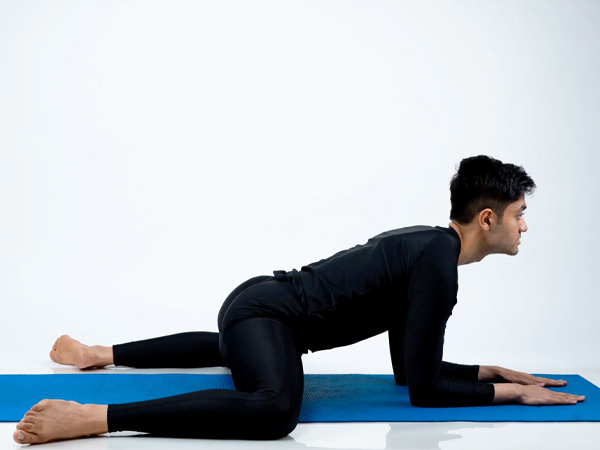
5. Frog Pose (Mandukasana)
Beneficial for the hips, thighs and spine, the frog pose may help in relieving sprains or back pains [7].
How to do Mandukasana:
- Lay on the floor with hands and knees lifting you from the floor.
- Position the knees a few inches apart and place the feet right behind the knees.
- Place the palms right under the shoulders with the fingers facing forward.
- Look downwards and focus on a point between your hands.
- Now, push the tailbone towards the back, stretching the spine.
- Slowly move the knees outwards to the sides.
- Then align the ankles and feet with the knees in a straight line.
- Start to slide downwards while keeping the palms flat against the floor.
- Exhale and keep pushing the hips backwards until a stretch is felt.
- Now, hold this position for three to five breaths.
- Come back to the table position again.
Note for parents: If the pose is putting extra force on the knees or the elbows of the child and hurting them, place a folded blanket to provide support and strength.
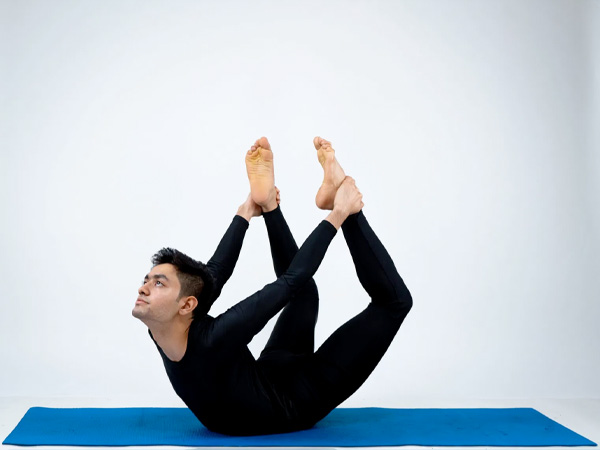
6. Bow Pose (Dhanurasana)
This pose helps stretch the abdomen, back, thighs, arms and chest. The bow pose is also beneficial for improving the hip flexor function and regulates the digestive system [8].
How to do Dhanurasana
- Lie flat on your tummy.
- Raise your legs backwards and take your hands behind your ears.
- Now catch your toes with your hands.
- Support your body weight with your abdomen.
- While inhaling deeply, try to lift your knees higher.
- Hold the posture for 15 to 30 seconds while breathing normally.
- Exhale and slowly relax, stretching out your body.
Note for parents: As this pose involves a lot of stretching, let your child take time.
READ RELATED: Coronavirus: School reopenings WILL trigger outbreaks
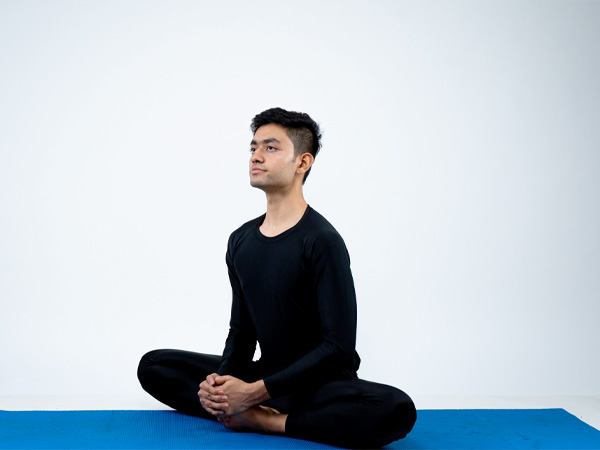
7. Butterfly Pose (Baddha Konasana)
The butterfly pose is beneficial for the muscles and ligaments of the urogenital region and helps improve flexibility. Also, it facilitates the supply of fresh oxygenated blood to the groin region (beneficial during periods). In addition, it regulates the intestine and bowel movement [9].
How to do Baddha konasana:
- Sit on the floor with legs stretched out.
- As you inhale, draw your feet towards you, keeping the soles of the feet together and your back straight.
- Now, place your hands on your knees or grab onto the toes.
- Stay in this asana for as long as you are comfortable.
- As you exhale, return to the starting position.
Note for parents: If the kid has a knee or groin injury, keep a blanket under the thighs to prevent pain or ache. If the injury is severe, avoid this pose.
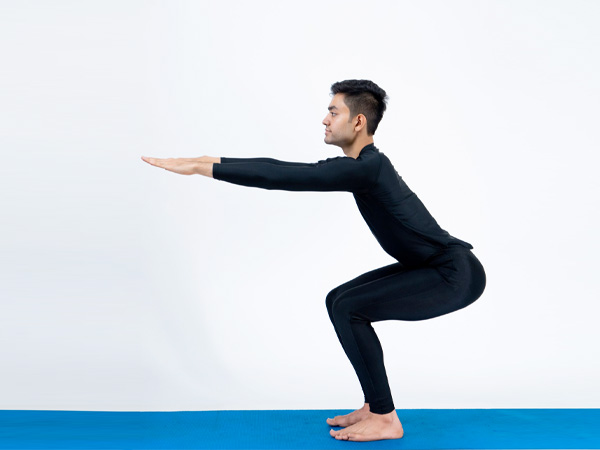
8. Chair Pose (Utkatasana)
Also called the held squat, doing the yoga chair pose can improve and strengthen the lower muscles. That is, it helps strengthen your lower back, spine and hips [10].
How to do Utkatasana:
- Stand straight on the floor and place your feet slightly apart.
- Stretch your arms forward, with your palms are facing downwards and arms straight.
- Then, gently bend your knees and push down your pelvis; that is as if you are sitting in a chair.
- Stay in the position, keeping your spine straight and hands parallel to the floor.
- Hold the pose for 1 minute.
- Now to get back to the position, first straighten your knees, followed by inhaling and then lift your body and exhale.
Note for parents: If your child is experiencing headaches or insomnia, do not perform this asana.
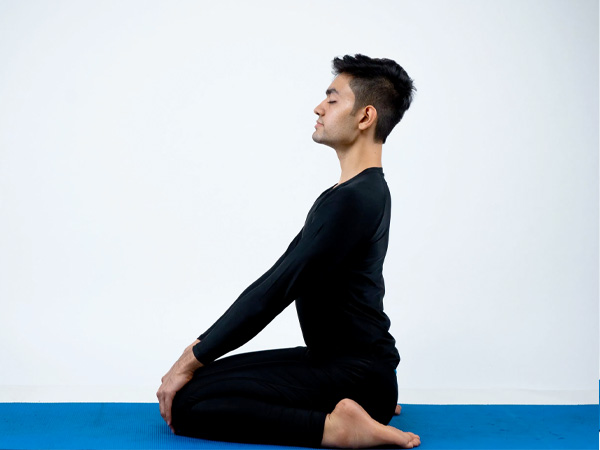
9. Hero Pose (Virasana)
Practising the hero pose is shown to help stretch the spine, quadriceps, and shoulder. It is also said to help improve blood circulation and digestion [11].
How to do Virasana:
- Sit with the knees together and the feet hip-width apart.
- Sit on the heels with the heels touching the hips.
- The hands should rest on the knees with the palms facing up.
- Straighten the spine and drop the shoulders down and a little towards the back.
- Relax the core while taking deep breaths.
- Retain the posture for as long as it is comfortable.
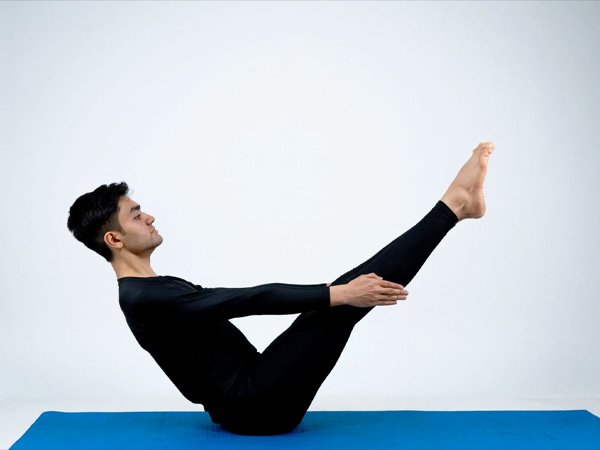
10. Boat Pose (Naukasana)
One of the most effective yoga poses for toning the muscles, the boat pose, contracts your abdominal muscles. As a result, it strengthens the core, shoulders and thighs. In addition, Naukasana is shown to help with constipation and alleviates digestive problems [12].
How to do Naukasana:
- Sit with your legs stretched forward.
- Keep your back straight.
- Take a deep breath in and exhale while lifting your head, chest, and legs from the ground. Hold the position for 30-60 seconds while breathing normally.
- Inhale, and then exhaling deeply, slowly relax and come back to your first position.
- Repeat five times.
Note for parents: If your kid suffers from any chronic disease or spinal cord problems, avoid the pose.
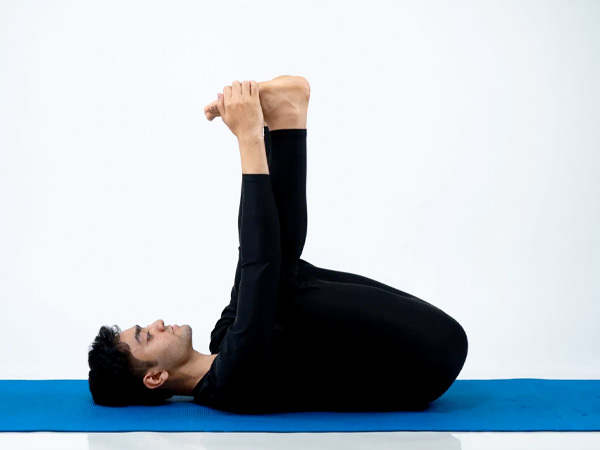
11. Happy Baby Pose (Ananda Balasana)
Ananda balasana stretches your spine and is highly effective to cure muscle pain [13]. It also helps elongate the spine and strengthens the arms and shoulders.
How to do Ananda balasana:
- Lie on the back with the knees drawn in towards the chest.
- Hold the feet with hands. Ensure that the arms are in front of the torso.
- Draw the shoulders to the back.
- Slightly stretch the arms and feet.
- Draw the knees wide apart, as much as comfortable.
- Elongate the lower back down to the ground while touching the tip of the tailbone.
- Retain the position for a minute or less, and then release.
Note for parents: If your kid has any knee or ankle injury, check with a doctor before performing this pose.
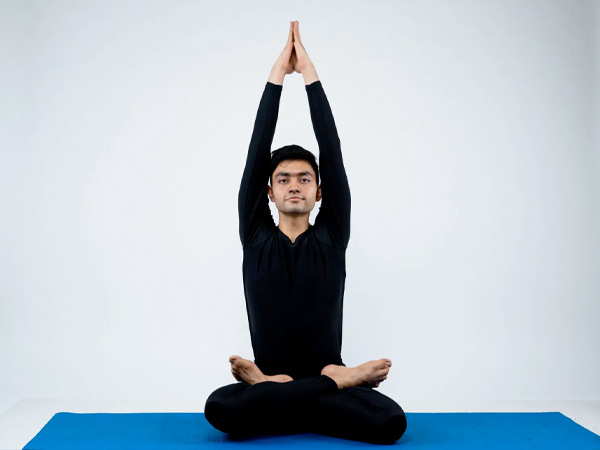
12. Mountain Pose (Tadasana)
A warm-up pose, this yoga asana help improves blood circulation, posture and strengthens the thighs, legs, and ankles.
How to do Tadasana:
- Stand on your feet and spread your heels (you can also do this sitting down).
- The back must be straight, and the hands must be on each side of the body.
- Take a deep breath and stretch the spine.
- Raise the palm up above the head.
- Lift your ankles and stand on your toes.
- Do this five times.
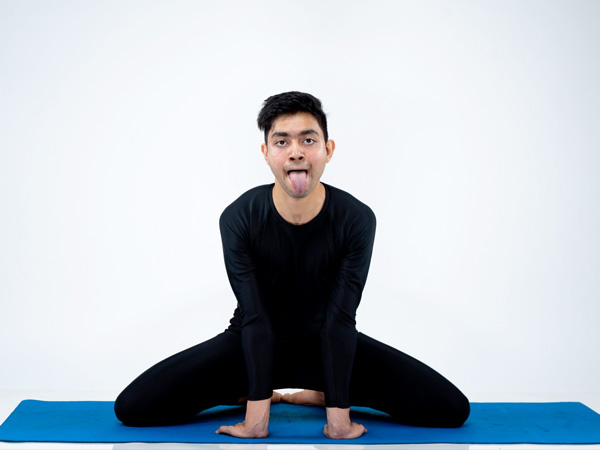
13. Lion Pose (Simhasana)
Lion pose is said to help stretch the lungs, throat, and respiratory tract and help regulate the tonsils and the immune system. In addition, some yoga experts have mentioned that the lion pose can help manage anger and anxiety in children [14].
How to do Simhasana:
- Sit with the hips on the heels.
- Rest the palms on the knees.
- Start inhaling from the nose, and while you are on it, stick your tongue out.
- Keep the eyes wide open, exhale through the mouth, and make a sound of a roaring lion.
Note for parents: Do it only five times in one go and NEVER more than that as it may cause minor breathing trouble or cause the child to cough.
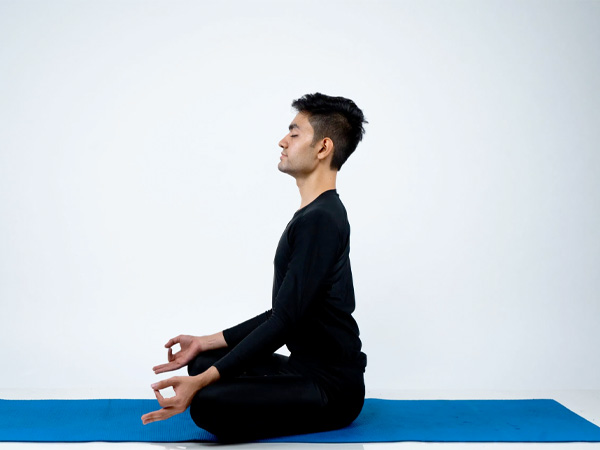
14. Easy Pose (Sukhasana)
As the name suggests, this yoga pose is the simplest of all poses that the child can try. The easy posture is good for the back, thighs, and hips. It may help in negating anxiety and stress [15].
How to do Sukhasana:
- Sit upright with legs crossed.
- Rest the hands on the knees with the palms facing up.
- Evenly balance the weight across the sit bones.
- Keep the head, neck, and spine aligned all along.
- Elongate the spine but without stiffing the neck.
- The feet and thighs should be relaxed.
- Retain this posture for a minute.
- Release and change the cross-legged position.
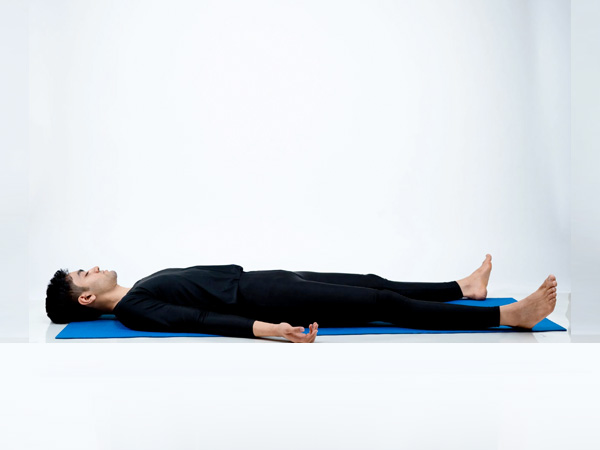
15. Corpse Pose (Savasana)
The corpse pose is a deep, meditative state of rest, practised at the end of every yoga session. It might seem the simplest of all but requires a whole lot of concentration. Savasana help reduce anxiety and high blood pressure and helps reduce insomnia and fatigue; improve productivity, memory, and concentration.
How to do Savasana:
- Lie flat on your back.
- Let your legs and hands relax entirely and place your legs apart.
- Keep arms alongside with your palms facing up.
- Relax your entire body.
- Pay attention to different parts of your body, one by one.
- Start with your right foot, move into the knee and then the thigh.
- Do it with the other leg as well.
- Breathe gently and deeply.
- After 10-20 minutes, roll onto your right side.
- With the support of your right hand, slowly sit up comfortably.
- Keep your eyes closed, gently breathe in and out.
Note for parents: As the savasana relaxes the whole body, there are chances that one may feel relatively cold after. So have a sweater or a pair of socks around your kid.
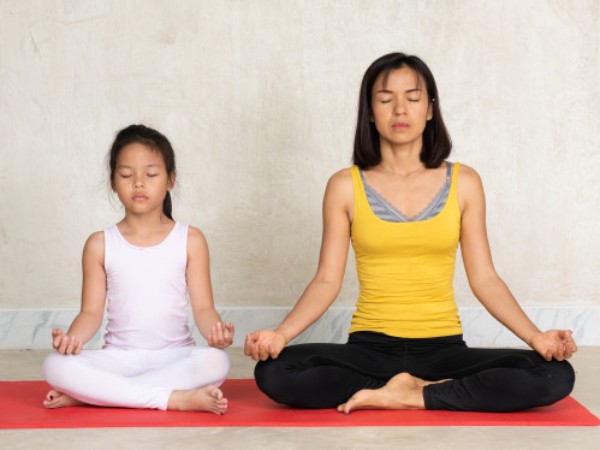
On A Final Note…
Irrespective of your age or body type, yoga is beneficial for you. However, yoga should not be performed in a state of exhaustion, illness, in a hurry or an acute stress condition. Also, do not perform yoga immediately after meals.
[image source: pixahive]
GET THE BEST BOLDSKY STORIES!
Allow Notifications
You have already subscribed
Source:









